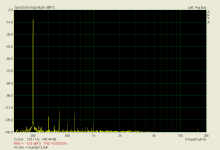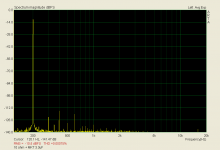Tried something more practical, R-C filter, 10 ohm + 3.3uF, at 200Hz, capacitor voltage is 5Vrms. I have checked Mundorf MCap Zn and Roederstein MKT, both 3.3uF. Both are excellent, distortion is below 0.001% and is affected by the method, so the capacitor distortion is probably even lower. So even MKT (polyester) caps will make a good job in a speaker filter.
Attachments
Pavel,
Obviously your results are flawed, because they show that same spike I often get in my setup between 10-20K. 🙂. However it seems you either found a really good pair of capacitors and/or you are at your limit of testing.
Nice show!
Obviously your results are flawed, because they show that same spike I often get in my setup between 10-20K. 🙂. However it seems you either found a really good pair of capacitors and/or you are at your limit of testing.
Nice show!
I am at the limit. When I measure voltage across the resistor (previous measurement was across capacitor), distortion is slightly higher, about 0.013%, but again same with both capacitors, and again acceptable for use in crossover filters.
THD vs. frequency, measured across the 3.3uF capacitor, was below 0.002% through whole 20Hz - 20kHz range.
That 15.625kHz spike disappers when I put the filter into a shielded box.
THD vs. frequency, measured across the 3.3uF capacitor, was below 0.002% through whole 20Hz - 20kHz range.
That 15.625kHz spike disappers when I put the filter into a shielded box.
Last edited:
That 15.625kHz spike disappers when I put the filter into a shielded box.
Or put the CRT TV into a shielded box. 😀
se
and attempt to refute Walt and me. Go for it!
There's nothing to refute, I just want to see an honest quantification of the effects in situ. Invariably the DA effects on waveform envelope in an RIAA are small fractions of a dB and certainly lost in any reasonable component tolerance.
As for the distortion, isn't it in the class of low order vanishing with signal going to zero just like speakers, open-loop class A amps, LP's, etc? Dick found .03% seconds bothersome on Charles Hanson's PONO output stage. How many amps and preamps have you and Nelson done with similar measurements at full scale? Don't you see the conflict with your design philosophy?
Be careful with your challenges! I redid your weird 741 test some years ago.
It was in this very same thread, and I debunked your claim that there was
mysterious non-harmonic distortion. I even gave the intermodulation order by
stepping the signal source frequencies by a few Hz and watching the questionable
IMD move around by 9 times the step size or so.
I don't think Otala actually made that claim just neglected to label all the spurs on his graph. Others took it from there. I'll bet JC still won't admit they can't exist.
Gentlemen,
would this be of any help in discussion.
Active circuit under electron microscope or this
Newbie here, so please be gentle. 😱
would this be of any help in discussion.
Active circuit under electron microscope or this
Newbie here, so please be gentle. 😱
Voltage contrast microscopy? I did that at uni. Evil old beast we had to use. It was called SEM2 as SEM1, the first ever made in UK was in a museum ( I kid you not). Used KT88s. I can't see how it helps but its good fun 🙂
I did, hence my question mark - as I could not see what relevance either link has to our discussion here. Perhaps Hiten will explain?
There's nothing to refute, I just want to see an honest quantification of the effects in situ. Invariably the DA effects on waveform envelope in an RIAA are small fractions of a dB and certainly lost in any reasonable component tolerance.
As for the distortion, isn't it in the class of low order vanishing with signal going to zero just like speakers, open-loop class A amps, LP's, etc? Dick found .03% seconds bothersome on Charles Hanson's PONO output stage. How many amps and preamps have you and Nelson done with similar measurements at full scale? Don't you see the conflict with your design philosophy?
unrelated but ---
Just a thought.... IM wasnt tested. wonder what levels it might show.
Maybe, I've said this before, a single test tone and multitone - like music -dont give the same low THD? How could it remain as low as the single tone THD? It must be a lot higher.... and That is what we hear but havent measured....... we compare apples to oranges...... a single tone to a multi-tone in affect and get misleading conclusions.
yes/no ??
THx-RNMarsh
Richard and John claim that DA causes DISTORTION.
That's their claim, not mine. The data they present does not back up that claim. Re-asserting the claim doesn't make it any more true.
You keep putting non-linearity into my DA tests and say I showed it here with spectra plots of it. never happened. I just say distortion (of waveform to transients, in particular).
Reasserting your transforming my description of DA as distortion to non-linearity doesnt make it true either.
Dont lump Jungs, comments/tests or Curls' in with mine.
TH-RNMarsh
It must be a lot higher.... and That is what we hear but havent measured....... we compare apples to oranges...... a single tone to a multi-tone in affect and get misleading conclusions.
yes/no ??
THx-RNMarsh
No, not a valid conclusion. We have been using multi-tone testing for years in comms. The spectral contamination is predicted by THD and it is not a "lot" higher. I'll post a sim later if I get time using 30 - 1/3 octave spaced tones. Think in terms of total power in the harmonics and that line of reasoning falls apart.
BTW I really do wish this music is asymmetric stuff would just go away.
Last edited:
You keep putting non-linearity into my DA tests and say I showed it here with spectra plots of it. never happened. I just say distortion (of waveform to transients, in particular).
Reasserting your transforming my description of DA as distortion to non-linearity doesnt make it true either.
Dont lump Jungs, comments/tests or Curls' in with mine.
TH-RNMarsh
You're right, John posted the spectra. But when you say things like, "I don't know that DA is linear.... the simple models show it that way. I figure it isnt purely linear due to the FFT result," one might conclude that you agree with his characterization.
Scott, if you want a serious analysis of FM distortion and the TIM test signal with low slew rate IC's, then read:Ron Quan's AES paper # 8722 from the 133th convention in 2012. pp. 16-22. Get back to me after you have read this carefully, if you will.
Last edited:
No, not a valid conclusion. We have been using multi-tone testing for years in comms. The spectral contamination is predicted by THD and it is not a "lot" higher. I'll post a sim later if I get time using 30 - 1/3 octave spaced tones. Think in terms of total power in the harmonics and that line of reasoning falls apart.
BTW I really do wish this music is asymmetric stuff would just go away.
Ok Maybe not a LOT higher on power basis.... just higher.... and power-wise, sure. I wasnt thinking total power..... something more akin to a hearing model would do.
I would like to see how much higher and if combined in other useful ways, also.
Thx-- Richard
Last edited:
You're right, John posted the spectra. But when you say things like, "I don't know that DA is linear.... the simple models show it that way. I figure it isnt purely linear due to the FFT result," one might conclude that you agree with his characterization.
No, I only know what I think i know... Esp if their test was different method than mine. Just let each speak for themselves.
I dont know if the model for DA is 'ideal' or not. That's what i thought to convey. Because I dont know. I mean the DA model doesnt show any of the other parasitics we know are there. So, I assume it is ideal.
THx-RNMarsh
Last edited:
I just say distortion (of waveform to transients, in particular).
And I say you need a good refresh about the Fourier dude. Waveform (in the time domain) distortion is no proof of distortion. Pass a square wave through a low pass filter and see what you get.
For any imaginable causal waveform resulting from a step response, there is a realizable linear circuit that would create it. It's called circuit synthesis, you know.
And I say you need a good refresh about the Fourier dude. Waveform (in the time domain) distortion is no proof of distortion.
Dick has been clear and stated explicitly that he uses the term "distortion" in a non-standard way.
- Status
- Not open for further replies.
- Home
- Member Areas
- The Lounge
- John Curl's Blowtorch preamplifier part II

